

Diverse Teaching Strategies for Diverse Learners. Do's & Don'ts For Teaching English-Language Learners. The number of English-Language Learners in the United States is growing rapidly, including many states that have not previously had large immigrant populations.
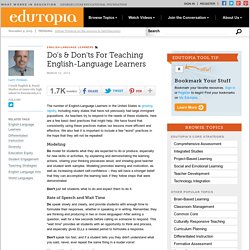
As teachers try to respond to the needs of these students, here are a few basic best practices that might help. We have found that consistently using these practices makes our lessons more efficient and effective. We also feel it is important to include a few "worst" practices in the hope that they will not be repeated! Modeling Do model for students what they are expected to do or produce, especially for new skills or activities, by explaining and demonstrating the learning actions, sharing your thinking processes aloud, and showing good teacher and student work samples. Strategies for Teaching ELL Student in the classroom. Teaching students who have a limited understanding of the English language can be a daunting task.
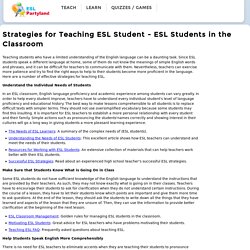
Since ESL students speak a different language at home, some of them do not know the meanings of simple English words and phrases, and it can be difficult for teachers to communicate with them. Nevertheless, teachers can exercise more patience and try to find the right ways to help to their students become more proficient in the language. A Guide to Learning Disabilities for the ELL Classroom Practitioner. Home > ELL Topics from A to Z > A Guide to Learning Disabilities for the ESL Classroom Practitioner By: Christine Root (1994) In many countries, learning disabilities are not recognized or, in some cases, they are recognized but not dealt with.

This paper is meant to be a basic primer on learning disabilities. Types of Learning Disorders and Their Signs. What are learning disabilities?
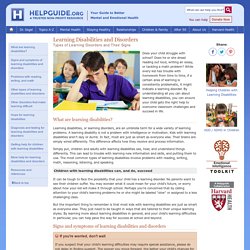
Learning disabilities, or learning disorders, are an umbrella term for a wide variety of learning problems. A learning disability is not a problem with intelligence or motivation. Kids with learning disabilities aren’t lazy or dumb. In fact, most are just as smart as everyone else. Their brains are simply wired differently. Simply put, children and adults with learning disabilities see, hear, and understand things differently.
Successful Strategies for Teaching Students with Learning Disabilities. Research continues to confirm that we can teach students with learning disabilities to “learn how to learn.”
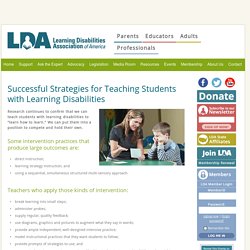
We can put them into a position to compete and hold their own. Some intervention practices that produce large outcomes are: direct instruction;learning strategy instruction; andusing a sequential, simultaneous structured multi-sensory approach. Teachers who apply those kinds of intervention: break learning into small steps;administer probes;supply regular, quality feedback;use diagrams, graphics and pictures to augment what they say in words;provide ample independent, well-designed intensive practice;model instructional practices that they want students to follow;provide prompts of strategies to use; andengage students in process type questions like “How is the strategy working?
Scaffolding is also something that seems to make a real difference. Educational Programs which support children with learning disabilities. National Institute for Learning Development Canada. NILD Educational Therapy stimulates areas of weakness through individualized and intensive intervention.
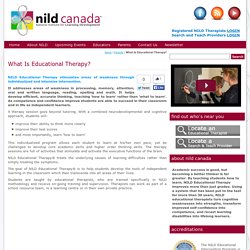
It addresses areas of weakness in processing, memory, attention, oral and written language, reading, spelling and math. It helps develop efficient, accurate thinking, teaching ‘how to learn’ rather than ‘what to learn’. As competence and confidence improve students are able to succeed in their classroom and in life as independent learners. A therapy session goes beyond tutoring. What is it like to have an intellectual disability - The F.A.T. City Workshop. Strategies for children with intellectual disability. Strategies for children with intellectual disabilities. Teaching Strategies for Students with Intellectual Disabilities. Written by: Sharon Dominica • edited by: Elizabeth Wistrom • updated: 9/11/2012.
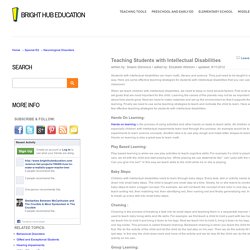
Teaching Students with Physical Disabilities. There are many teaching strategies you can use to ensure effective and productive learning environments and experiences for all students, including those with disabilities.

Accessible Education[i] is the process of designing courses and developing a teaching style to meet the needs of people who have a variety of backgrounds, abilities and learning styles. Just as there is no single way to teach, people learn in a variety of ways; using different instructional methods will help meet the needs of the greatest number of learners[ii]. Strategies Teaching Children with a Physical Disability.
Physical Development Strategies. Teaching Hearing Impaired Children. Teaching Hearing Impaired Children By Ron Doorn Hearing is what keeps us in touch with our world.
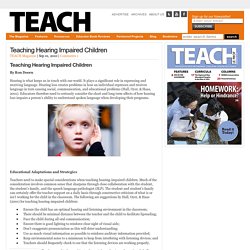
It plays a significant role in expressing and receiving language. Teaching Students who are Deaf, Deafened or Hard of Hearing. There are many teaching strategies you can use to ensure effective and productive learning environments and experiences for all students, including those with disabilities.

Accessible Education[i] is the process of designing courses and developing a teaching style to meet the needs of people who have a variety of backgrounds, abilities, and learning styles. Just as there is no single way to teach, people learn in a variety of ways; using different instructional methods will help meet the needs of the greatest number of learners[ii].
Under the Accessibility for Ontarians with Disabilities Act, you have a responsibility to learn about accessibility for persons with disabilities and how it relates to the development and delivery of accessible programs and courses. What does it mean if someone is Deaf, deafened or hard of hearing? People who have hearing loss may be Deaf, deafened or hard of hearing. Suggested tips on teaching a person who is Deaf, deafened or hard of hearing. Educational Interventions for Students with Low Vision. Approximately 90% of individuals with visual impairments have functional or low vision; just 10% are functionally blind. However, students with low vision are often an overlooked majority in the population of children who are visually impaired. Difficulties of students with low vision are often not as apparent as they are for students who are blind.
Nonetheless, students with low vision require direct instruction in literacy, visual efficiency, accessing the core curriculum, compensatory skills and more. Culture in the Classroom. Educators today hear a lot about gaps in education – achievement gaps, funding gaps, school-readiness gaps. Still, there's another gap that often goes unexamined: the cultural gap between students and teachers. "A bunch of teachers here, they think they know what's wrong with us. But they don't know. If people want to help us, they have to see what we've been through, not from what their own experiences tell them.
" – Billie, a Lakota teen speaking of the teachers at her high school Most of us in the education profession are white, middle-class, monolingual-English speakers. But the truth is: culture matters. Culture isn't just a list of holidays or shared recipes, religious traditions, or language; it is a lived experience unique to each individual. Crossing Borders with multicultural literature. Aboriginal brochure for inclusion. Speech and language difficulties in the classroom. Speech & Language Resources. Autism in the Classroom. Teaching Autism Students in Inclusive Classrooms Are we teaching autism students effectively in inclusive classrooms so that they are able to benefit from their educational programs? The information, research and articles below offer teachers practical tips and strategies on how to teach students with autism in inclusive classrooms.
Parents may find the information useful as well. Please consider sharing it with your child's teacher. Educational Resources for Social and Behavioural Skills. Teaching Tips for Children and Adults with Autism. Resources > Articles Temple Grandin, Ph.D. Assistant Professor Colorado State UniversityFort Collins, CO 80523, USA (Revised: December 2002) Good teachers helped me to achieve success. I was able to overcome autism because I had good teachers.
At age 2 1/2 I was placed in a structured nursery school with experienced teachers. Between the ages of 2 1/4 and 5 my day was structured, and I was not allowed to tune out. Additional Resources for Children with Autism. Autism. Strategies for Emotional Disturbance. Educational Strategies for children with emotional and behavioural problems. Developmental Delays: Tips for Teachers. Written by: Lisa Pulsifer • edited by: Elizabeth Stannard Gromisch • updated: 8/2/2012. Teaching Learners with Multiple Special Needs. Activities and Ideas for Teaching Children with Multiple Disabilities.